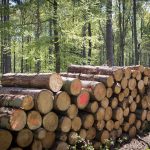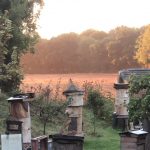Natural Beehives In Needwood
Visitors to the natural beauty spot known as Jackson’s Bank in the Needwood Forest in Staffordshire may have noticed that six silver birch trees have been felled near the picnic area in recent months. This is because the trees had reached maturity and, as part of the Duchy’s ongoing woodland management plan, they have now been replaced with English oaks, one of which is registered as part of The Queen’s Green Canopy, a green legacy which will commemorate Her Majesty’s 70 years of service.
As part of its sustainability plan the Duchy is also keen to recycle raw materials such as timber, finding new and creative uses for our redundant or cut trees wherever appropriate. In the past this has included deliveries to the local sawmill for conversion into insulation and heating materials, gifts of timber to local schools for outside shelters and forest schools and timber fencing for local farming tenants. The latest innovative use of any felled or fallen trees has been as natural beehives, thanks to a couple of local amateur bee-keepers.
Michele Dehavilland and Peter Hodson started designing, making and sharing natural beehives last year after a tree in Michele’s garden was blown down in a storm. Together, they came up with the idea of using disused timber to create natural habitats for bees, helping to protect these natural pollinators in an environmentally friendly, organic and sustainable way.
Commenting on the initiative Duchy Head of Rural Carol Hawkey said: “We are always happy to support new initiatives designed with the long-term sustainability of our estates in mind. We congratulate Michele and Peter on this initiative – and for supplying other tenants across the Duchy’s Needwood estate with a regular supply of natural beehives and delicious locally produced honey.”
Over the last two years, the Duchy of Lancaster team has been working with independent forestry consultants and the National Forest to plant more than 175 new avenue trees across the estate and complete the first phase of a five-year woodland creation plan designed to help reintroduce native species such as oak, lime, silver birch, Scots pine and field maple to this area of the ancient Royal Needwood Forest.


